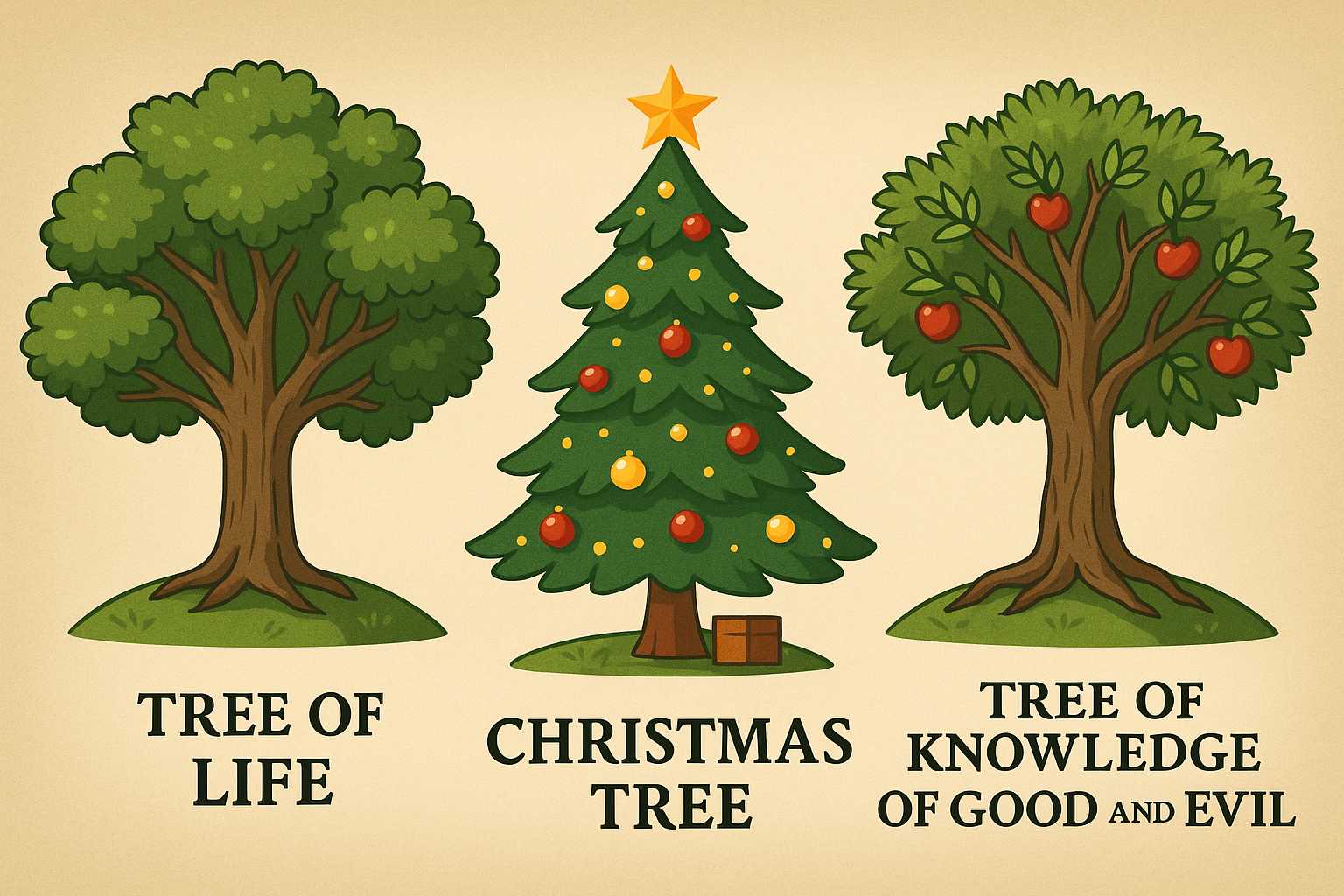The Bible doesn’t mention putting up a tree to celebrate the birth of Christ. While the Scripture details the event and its meaning, the early church didn’t include Christmas as a holiday. However, today the Christmas tree is a staple in most homes around the holidays, in America and around the world. In my house, we put up the tree and decorate for Christmas the day after Thanksgiving. Some people do it even earlier in November. We place cherished ornaments on the tree while watching a Christmas movie or listening to a classic Christmas album by Bing Crosby or Elvis.
As much as the decorated tree has become inseparable from celebrating the birth of Jesus, is it in the Bible?
Does the Bible Mention Christmas Trees?
The Gospels of Matthew and Luke tell us the story, beginning with the angel announcing Jesus’ conception to the virgin Mary first, and later to Joseph. They journeyed to Bethlehem, where Jesus was born in a manger since there was no room at the inn. More angels show up and announce his birth to the shepherds in the fields, saying, “Glory to God in the highest, and on earth peace, good will toward men” (Luke 2:14). These shepherds visit the Son of God, themselves glorifying and praising God. Matthew recounts how the Magi, or wise men, followed a star to find Jesus. They brought gifts of gold, frankincense, and myrrh. These accounts focus on the importance of Christ’s miraculous coming but don’t instruct any type of celebration.
The Christmas tree, specifically, isn’t mentioned in Scripture, either. Some point to Jeremiah 10:1-5 which discusses cutting down a tree and decorating it with silver and gold. However, the context condemns idolatry, not anything for God’s people. Using this passage for Christmas trees misrepresents the Scripture.
While the Bible doesn’t command the celebration of Christ’s birth, Paul allows for personal conviction in observing special days, as long as it’s done unto God and not placed as an obligation on all people (Romans 14:5-6). Christmas could be considered such a special day. The Bible does see the virgin birth as central to the Gospel, including it in Matthew and Luke and mentioning the theological importance of the incarnation (John 1:14; Philippians 2:6-8). In this context, Christmas celebrations aren’t necessarily against Scripture, especially if they declare Jesus’ redemptive work.
Are Christmas Trees Biblical?
Like the Bible doesn’t give any instruction to celebrate Jesus’ birth as a separate holiday, the early church didn’t celebrate it, either. The church of the first couple centuries focused on Jesus' death and resurrection, or what we call Easter. Some of this was influenced by the Jews who made up most of the church at the beginning. The Jewish people still focused on the Old Testament festivals, especially Passover, which now included and expanded to Jesus’ death and resurrection. Also, Jews and early Christians didn’t celebrate birthdays, which were more associated with pagan customs. A celebration of Jesus’ birthday wouldn’t have made sense to them.
As more Gentiles converted and Christianity spread across the Roman Empire, the church began celebrating Jesus’ birthday. By the fourth century, Christians established December 25 to mark the day. This date may have been chosen as a Christian option to the popular but pagan festival of Saturnalia, a winter solstice celebration, or possibly the Roman holiday of Sol Invictus that honored the “Unconquered Sun.” Christians reimagined these festivals to symbolize Jesus as the Light of the World (John 8:12). Over the next few centuries, the feast of the Nativity spread throughout the Christian world. Church leaders focused on the incarnation and the fulfillment of Messianic prophecies.
By the Middle Ages, Christmas became a major holiday on the Christian liturgical calendar. Celebrations developed to include special church services, nativity plays, and more. The Christmas season extended to Epiphany (January 6) and incorporated other traditions over time, some from pagan origins.
The Protestant Reformation (16th century) led to various perspectives on Christmas. Some reformers resisted observing the holiday since the Bible doesn’t mention it. At the same time, others embraced it as a time to be with family and highlight Christ’s birth and the Gospel. Modern Christmas celebrations continued to evolve and gain popularity through the 19th century, influenced by literature like Charles Dickens’ A Christmas Carol and other popular media.
Origins of Christmas Trees and Christmas Celebrations
The Christmas tree developed through the rise of celebrating Jesus’ birth and adapting ancient and pagan traditions into Christianity.
Before Christianity, ancient cultures believed evergreen plants had symbolic meaning. People like the Egyptians, Romans, and Druids used evergreen branches during winter solstice festivals (like the Roman Saturnalia) to signify life and hope in the middle of winter. As Christianity spread, many pagan and cultural customs were interpreted through new Christian views. Evergreens now symbolized eternal life through Christ. Christian converts from these pagan cultures adapted to use evergreens in homes as churches to point to the hope and eternal life available through Jesus.
The tradition of decorating a whole tree for Christmas can be found in 16th century Germany. While some consider it legend, Martin Luther supposedly first added lights to a tree. Inspired by the beauty of stars shining on a winter night, people say he brought a tree indoors and placed candles upon it to represent the light of Christ. Two hundred years later, decorated Christmas trees, including ornaments, had become common among German Christians. Through trade and general interaction, the practice spread across Europe to England during the reign of Queen Victoria. Prince Albert, her husband of German descent, brought a Christmas tree into the British royal family, and this inspired others in England to adopt the tradition.
With such close ties between England and America, the Christmas tree became central to American holidays during the 19th century, brought by British and German immigrants. The popularity grew with new additions like electric lights and more elaborate ornaments.
Important Trees in Scripture
While the Bible doesn’t mention what we know as the Christmas tree, trees play a huge part in the Bible and have major theological implications.

Scripture begins with two important trees in the Garden of Eden, the Tree of Life and the Tree of the Knowledge of Good and Evil (Genesis 2:9). The Tree of Life provided immortality and eternal life, while the Tree of Knowledge represented how morality apart from God leads to death. When Adam and Eve disobeyed God and ate from the forbidden tree, the Lord exiled them from Eden, and they lost access to the Tree of Life (Genesis 3:22-24), which introduced death and mortality. As we can imagine, later references to trees in the Bible point back to these original trees.
Through the Psalms and prophetic books, trees also symbolize righteousness and judgment. Psalm 1 compares a righteous person to “a tree planted by streams of water, which yield its fruit in season and whose leaf does not wither.” This picture connects to the Tree of Life from Eden. In the prophets, Isaiah talks about the “Branch of the Lord” (Isaiah 4:2) and the “shoot from the stump of Jesse” (Isaiah 11:1), which both declare the coming Messiah. Ezekiel uses the image of a cedar tree to symbolize God’s Kingdom (Ezekiel 17:22-24), and Joel talks about creation’s restoration through vineyards and fig trees (Joel 2:22).
Jesus also talks about trees, notably when he engages a barren fig tree. He was hungry, and since he found it without fruit, Jesus curses the tree. It later withers (Mark 11). Christ used the tree to warn against spiritual sin and hypocrisy. In contrast, true repentance bears fruit in and out of season, again like Eden. Jesus also taught about the expansive nature of the Kingdom of God with how a mustard seed grows into a large tree (Matthew 13:31-32), hearkening back to Ezekiel 17.
The Bible ends with the return of the Tree of Life in the New Jerusalem (Revelation 22:2), given back to God’s people in the new earth. This tree bears fruit every month and has leaves for the healing of the nations. This fulfills God’s redemptive plan, bringing it back full circle. Remember, Jesus defined himself as the way, the truth, and the life. As he himself is life, the Tree of Life symbolizes Christ.
As we can see, adopting the evergreen as a Christmas symbol wasn’t a huge stretch for early Christians to adopt into Christmas celebrations.
Creative Ways Christians Can Use Christmas Trees
We all know the traditional way to set up and decorate a Christmas tree. However, there are several ways to be creative and innovative with the symbol, too.
1. The Scripture Tree
Instead of the traditional ornaments, decorate the tree with Scripture verses related to Jesus’ birth. Use passages from the Old and New Testaments like Isaiah 9:6, Luke 2:10-11, and John 1:14. The family can write these verses on ornaments or cards and hang them to remind each other of the true meaning of Christmas. You could extend this with devotionals, reading a verse a day and discuss before placing them on the tree.
2. Prayer Tree
In a similar way, use the Christmas tree to show prayer requests or praises. Write out the names of family members, close friends, missionaries, or other people in need on papers in the shape of hearts or crosses and hang them on the tree. During the season, at dinner or around the tree, pray for each person and need. This teaches the family how prayer is an amazing expression of love.
3. Acts of Kindness Tree
Create a tradition where each ornament on the tree represents an act of kindness. Each family member can make a decoration with paper or other craft and write their acts of service on it. These can include helping a neighbor, donating to an important charity, or even sharing the story of Jesus with someone. Add these to the tree, reminding each other how serving others expresses God’s love (Matthew 5:16).
4. Names of Jesus Tree
The Bible contains over 200 names for Jesus, and each has meaning. With these amazing possibilities, your family can decorate the tree with cards or ornaments with names like “Emmanuel,” “Prince of Peace,” “Light of the World,” or “Good Shepherd.” This becomes an opportunity to teach children the different attributes of the one Christ, making him the center of the holiday and the family.
Or you could combine two or more of these ideas. Or all four! Don’t let modern traditions limit what can be a creative and amazing expression of truth and love through Christ in your home and family. These ideas keep the focus on Jesus with the Christmas tree while creating new and memorable traditions.
Peace.
Photo credit: ©GettyImages/ Siri Stafford





.jpg)